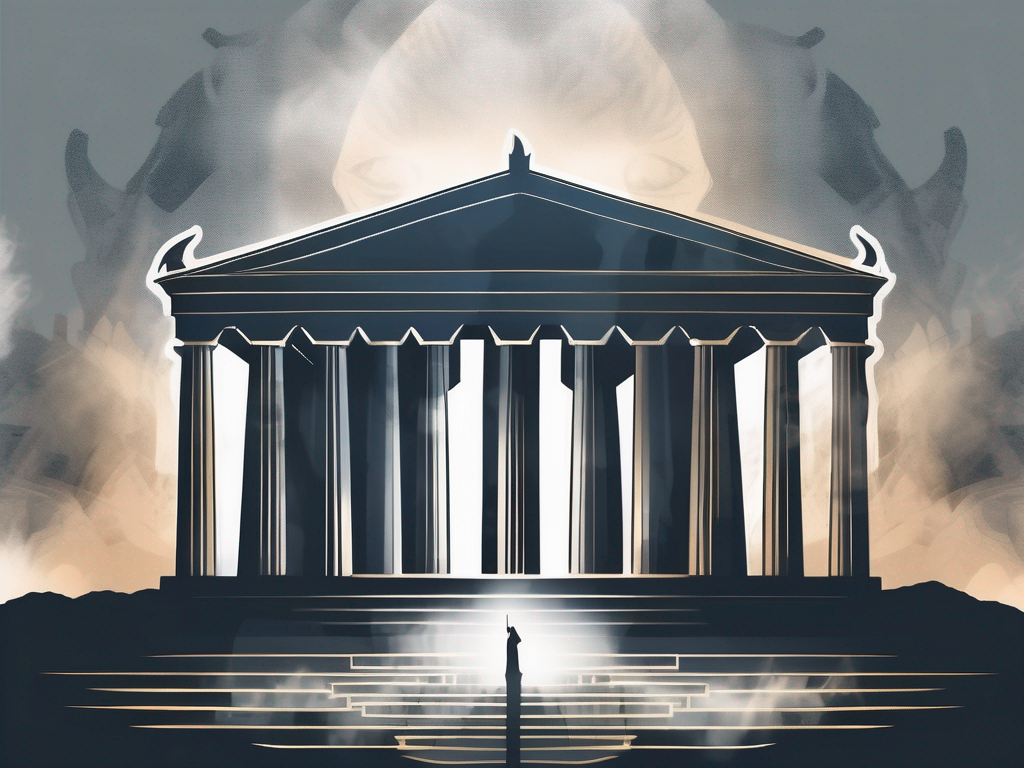In the vast and captivating pantheon of ancient Egyptian deities, the god Aker looms as a fascinating enigma. Known for his role in the intricate web of Egyptian religious beliefs, Aker holds a unique place in the hearts and minds of scholars and enthusiasts alike. Join us on a journey to unravel the mysteries surrounding this extraordinary god.
Understanding the Role of Aker in Ancient Egyptian Religion
At the very foundation of Aker’s significance lies his association with the Earth and the horizon. Representing the dual nature of the horizon, Aker held immense influence over the cyclical patterns of life, death, and rebirth in ancient Egyptian cosmology.
What truly sets Aker apart is his portrayal as a dual lion deity. In a pantheon full of animal-headed gods, such a depiction was unparalleled. This unique representation reflects the multifaceted nature of Aker and his omnipresent power.
Aker’s Association with the Earth and the Horizon
Aker’s deep connection to the Earth and the horizon made him a revered figure in Egyptian cosmology. As the guardian of the gateway between the earthly realm and the afterlife, he held the keys to the mysteries of existence.
The Earth, personified by Aker, was believed to take the form of a lion lying on its side, symbolizing the sunrise and sunset. This dual aspect of Aker further emphasized his role in the perpetual cycles of life and death.
Aker’s association with the Earth extended beyond its physical representation. He was believed to have control over the fertility of the land, ensuring bountiful harvests and abundance for the people. Farmers and agricultural communities would often pay homage to Aker, seeking his blessings for a prosperous yield.
Furthermore, Aker’s connection to the horizon gave him the power to regulate the passage of time. As the sun rose and set, Aker’s presence could be felt, guiding the celestial bodies along their predetermined paths. This celestial navigation was crucial for the ancient Egyptians, as it allowed them to track the changing seasons and plan their agricultural activities accordingly.
The Dual Lion Deity: A Unique Representation
By embodying the traits of both lions and gods, Aker’s dual nature was key to unlocking the complexities of Egyptian religious beliefs. The lion form symbolized power, protection, and ferocity, while the divine aspect represented wisdom, authority, and majesty.
Through this extraordinary combination, Aker became the embodiment of the protective forces that governed the Earth’s eternal balance and the guardian of souls’ transition into the afterlife.
Aker’s lion form also held symbolic significance beyond its association with power and protection. Lions were revered for their strength and courage, making them the perfect representation of Aker’s ability to ward off evil and safeguard the living. It was believed that Aker’s presence alone could repel malevolent forces and ensure the safety of both the physical and spiritual realms.
Moreover, the lion’s association with kingship and royalty added another layer of meaning to Aker’s portrayal. As a dual lion deity, Aker embodied the divine authority of the pharaoh, the earthly representative of the gods. This connection elevated Aker’s status and further solidified his role as a guardian and protector of the Egyptian people.
In conclusion, Aker’s association with the Earth and the horizon, as well as his unique portrayal as a dual lion deity, made him a significant figure in ancient Egyptian religion. His multifaceted nature and omnipresent power allowed him to govern the cyclical patterns of life and death, protect the earthly realm, and guide souls into the afterlife. Aker’s influence extended beyond the physical world, encompassing the celestial realm and the spiritual well-being of the people.
The Symbolism and Iconography of Aker
Aker’s influence extended beyond religious beliefs and practices and seeped into the rich tapestry of ancient Egyptian art. In wall reliefs, sculptures, and hieroglyphic inscriptions, Aker’s presence is palpable and deeply woven into the fabric of Egyptian visual culture.
A recurring theme in Aker’s portrayal was his lion form, often depicted with a coiled serpent on his head, representing protection and the control over chaotic forces. This visual symbolism seamlessly merged the realms of the divine and earthly.
Aker’s lion form, with its fierce countenance and majestic presence, captivated the imaginations of ancient Egyptians. Artists skillfully rendered his features, capturing the essence of his dual nature and the power he held over the celestial and terrestrial realms.
Aker in Ancient Egyptian Art
Artistic representations of Aker showcase his duality in striking detail. With the head of a lion facing in opposite directions, Aker symbolized the East and the West and their connection to the rising and setting sun. This imagery reinforced his role as the gatekeeper of the celestial cycle.
As the sun rose in the east, Aker’s lion face turned to greet the dawn, symbolizing the beginning of a new day. Conversely, as the sun set in the west, his other lion face watched over the transition from day to night, ensuring the safe passage of the sun through the underworld.
Furthermore, Aker’s presence in tomb paintings, temples, and royal iconography served as a powerful reminder of his eternal guardianship over the Earth and the realm beyond. His image adorned the walls of sacred spaces, offering protection and guidance to both the living and the deceased.
The Significance of Aker’s Lion Form
The lion, revered for its strength and dominance, personified Aker’s earthbound aspects. It represented the physical realm and its struggles, while also signifying Aker’s protective nature towards humanity.
Aker’s lion form, with its fierce mane and powerful physique, embodied the ideals of courage and resilience. Just as the lion fiercely defends its pride, Aker stood as a guardian, shielding the Egyptian people from the forces of chaos and disorder.
As the embodiment of cosmic order and balance, Aker’s lion form acted as a formidable shield against the chaotic forces that threatened to disrupt the sacred harmony of Egyptian society. His presence reassured the people that the world was under the watchful eye of a benevolent deity, ensuring their safety and well-being.
In conclusion, Aker’s symbolism and iconography in ancient Egyptian art not only reflected his role as a protector and gatekeeper but also conveyed profound messages about the interconnectedness of the divine and earthly realms. Through his lion form, Aker embodied the ideals of strength, order, and protection, leaving an indelible mark on the visual culture of ancient Egypt.
Aker’s Influence on Egyptian Cosmology
Aker’s impact on Egyptian cosmology was profound, governing the daily journey of the sun across the sky and its perilous descent into the underworld. As a key figure in Egyptian mythology, Aker’s presence was intertwined with the core beliefs and rituals surrounding the sun god Ra.
According to ancient lore, Aker guarded the gates where the sun rose and set, ensuring the safe passage of Ra during his momentous journeys through the vast celestial expanse.
Aker and the Journey of the Sun
Aker’s vital role in Ra’s celestial odyssey stitched together the fabric of day and night. At sunrise, Aker aided Ra as he ascended into the heavens, protecting him from the clutches of the malevolent serpent Apep, who sought to devour the sun and plunge the world into eternal darkness.
During sunset, Aker once again demonstrated his unwavering devotion by standing as a guardian, shielding Ra from the monstrous serpent’s attempts to halt his return to the underworld.
Aker’s Role in the Underworld
In addition to his involvement with Ra’s journey, Aker held sway over the realm of the dead. As the sun vanished beneath the horizon, Aker guided Ra through the treacherous underworld, ensuring his safe passage in preparation for the new dawn.
By bridging the gap between the mortal realm and the afterlife, Aker played a vital role in maintaining cosmic order and establishing the foundations of an immortal existence for the departed souls.
The Worship and Cult of Aker
Aker’s enigmatic presence within Egyptian society was not limited to the realms of mythology and cosmology. His influence extended to sacred spaces, rituals, and ceremonies dedicated to his worship.
Temples and Sacred Spaces Dedicated to Aker
Throughout Egypt, numerous temples were constructed to honor and pay homage to Aker. These sanctuaries served as points of convergence for worshippers seeking solace, protection, and guidance in their physical and spiritual journeys.
Devotees would flock to these sacred spaces, partaking in rituals and offerings designed to appease Aker and benefit from his protective influence and benevolence.
Rituals and Ceremonies Associated with Aker
The rituals performed in honor of Aker varied in scope and purpose but were united in their desire to gain favor from the mighty deity. These ceremonies often involved prayers, chanting, and the burning of incense, creating an atmosphere brimming with reverence and spirituality.
Worshippers sought the blessings of Aker for various aspects of their lives, including health, abundance, protection, and safe passage into the afterlife.
Aker’s Legacy in Modern Interpretations
Aker’s impact continues to reverberate through the corridors of modern culture, leaving an indelible mark on popular media, scholarly discourse, and artistic expressions.
Aker in Popular Culture
In recent times, Aker has emerged as a captivating figure in literature, movies, and video games. His portrayal as a deity associated with balance, protection, and wisdom continues to captivate audiences with its rich symbolism and inherent allure.
By conceiving awe-inspiring narratives that draw inspiration from ancient Egyptian mythology, Aker has found his place in the hearts of those seeking to connect with the mythical past.
Modern Scholarly Perspectives on Aker
Within the scholarly community, Aker has been subject to extensive study and analysis. Egyptologists and historians have meticulously dissected his role and significance within the ancient Egyptian pantheon, deepening our understanding of this enigmatic god’s impact on religious beliefs and society.
Through ongoing research and excavations, scholars strive to unveil new insights into Aker’s multifaceted nature and unravel the mysteries that shroud this ancient deity.
Aker: A Divine Enigma Unveiled
As we delve into the profound realms of ancient Egyptian religion, the figure of Aker emerges as a fascinating embodiment of cosmic forces, guardian of the Earth, and guide to the afterlife. His dual lion form stands as a testament to the intricate tapestry of belief and symbolism woven into the fabric of Egyptian society.
Today, as we seek to comprehend the enigmatic nature of ancient gods, we find ourselves drawn to the unique allure of Aker – the ever watchful, ever powerful deity who invites us to explore the mysteries of eternity.












